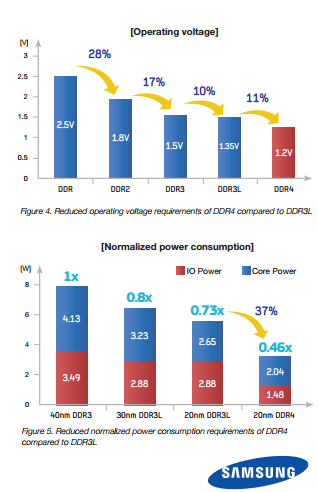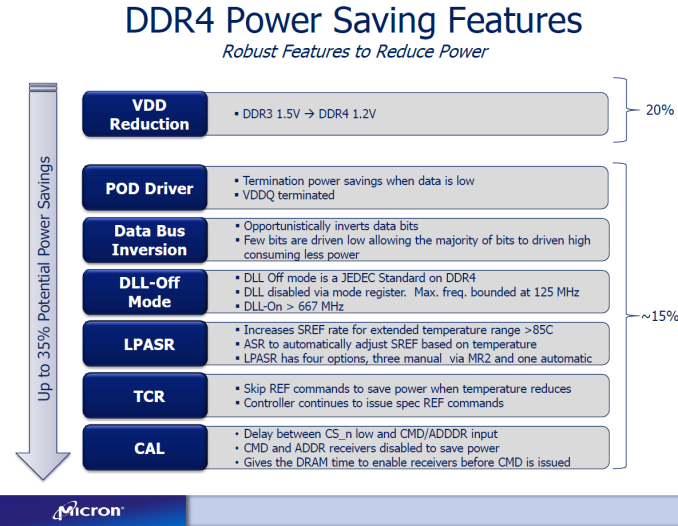Intel Xeon E5 Version 3: Up to 18 Haswell EP Cores
by Johan De Gelas on September 8, 2014 12:30 PM ESTDDR4
Intel and the DRAM world are switching over to DDR4 and with good reason. DDR4 is a large step forward, and some of the highlights of DDR4 include the following:
- Speeds up to 3200 MT/s (1.6GHz Double Data Rate)
- Lower DRAM I/O voltage (1.2 instead of 1.5 V VDDQ)
- Twice the capacity (using the same DRAM chips)
- Improved RAS
The improvements start with the internal organization. A DDR3 chip has eight independent banks, while DDR4 comes with 16 banks, organized in a 4x4 configuration: four bank groups with four banks. More banks mean that more pages can stay open (more page hits, lower latency) at a small power increase, which is completely negated by a whole range of power efficiency features (see further). The power efficiency gains are rather large. Samsung quantifies them in the slide below.
Samsung claims about 21% lower power thanks to the drop in operating voltage (1.5 ->1.2v). Low Power DDR4 will run at 1.05v and will lower the power usage even further. But there is more to DDR4 than lowering the voltage. Samsung claims that, when both are manufactured with the same process technology, the DDR4 runs at 2/3 of the power DDR3L needs.
Micron gives a break down of the features that made DDR4 more power efficient besides the obvious drop in VDDQ.
Note that the total power efficiency increase is 30-35%, and this is not just a result of the VDD reduction (20%). In that sense, DDR4 is a larger step forward than previous DDR technology transistions. Of course, the 30-35% improvement in power efficiency is measured with RAM running at the same speed. It's also possible to run DDR4 at much higher speeds (3200 MT/s vs 1866 MT/s) while sacrificing some of the power savings. The DDR4 memory that we are using for testings runs at 2100 MT/s, a good compromise between a mild speed increase and power efficiency.
A more elaborate discussion will follow in our next server memory article, but each bank also has much smaller rows (four times smaller) and thus the cycle time of the DRAM can be much higher. The result is lower latency.
The improved signal to noise ratio and the extra pins for addressing allow DDR4 to support eight DRAM stacks instead of four (DDR3). As a result, DDR4 can support twice the capacity of DDR3 using the same (4-16Gb) DRAM chips. This will require the use of 3D stacking technology, which will take time to implement. However, since 8Gb chips are now used, Registered DIMMs of 32GB should soon be a reality, as well as 64GB LRDIMMs. We'll discuss this in more detail on the next page.












85 Comments
View All Comments
coburn_c - Monday, September 8, 2014 - link
MY God - It's full of transistors!Samus - Monday, September 8, 2014 - link
I wish there were socket 1150 Xeon's in this class. If I could replace my quad core with an Octacore...wireframed - Saturday, September 20, 2014 - link
If you can afford an 8-core CPU, I'm sure you can afford a S2011 board - it's like 15% of the price of the CPU, so the cost relative to the rest of the platform is negligible. :)Also, s1150 is dual-channel only. With that many cores, you'll want more bandwidth.
peevee - Wednesday, March 25, 2015 - link
For many, if not most workloads it will be faster to run 4 fast (4GHz) cores on 4 fast memory channels (DDR4-2400+) than 8 slow (2-3GHz) cores on 2 memory channels. Of course, if your workload consists of a lot of trigonometry (sine/cosine etc), or thread worksets completely fit into 2nd level cache (only 256k!), you may benefit from 8/2 config. But if you have one of those, I am eager to hear what it is.tech6 - Monday, September 8, 2014 - link
The 18 core SKU is great news for those trying to increase data center density. It should allow VM hosts with 512Gb+ of memory to operate efficiently even under demanding workloads. Given the new DDR4 memory bandwidth gains I wonder if the 18 core dual socket SKUs will make quad socket servers a niche product?Kevin G - Monday, September 8, 2014 - link
In fairness, quad socket was already a niche market.That and there will be quad socket version of these chips: E5-4600v3's.
wallysb01 - Monday, September 8, 2014 - link
My lord. My thought is that this really shows that v3 isn’t the slouch many thought it would be. An added 2 cores over v2 in the same price range and turbo boosting that appears to functioning a little better, plus the clock for clock improvements and move to DDR4 make for a nice step up when all combined.I’m surprised Intel went with an 18 core monster, but holy S&%T, if they can squeeze it in and make it function, why not.
Samus - Monday, September 8, 2014 - link
I feel for AMD, this just shows how far ahead Intel is :\Thermogenic - Monday, September 8, 2014 - link
Intel isn't just ahead - they've already won.olderkid - Monday, September 8, 2014 - link
AMD saw Intel behind them and they wondered how Intel fell so far back. But really Intel was just lapping them.